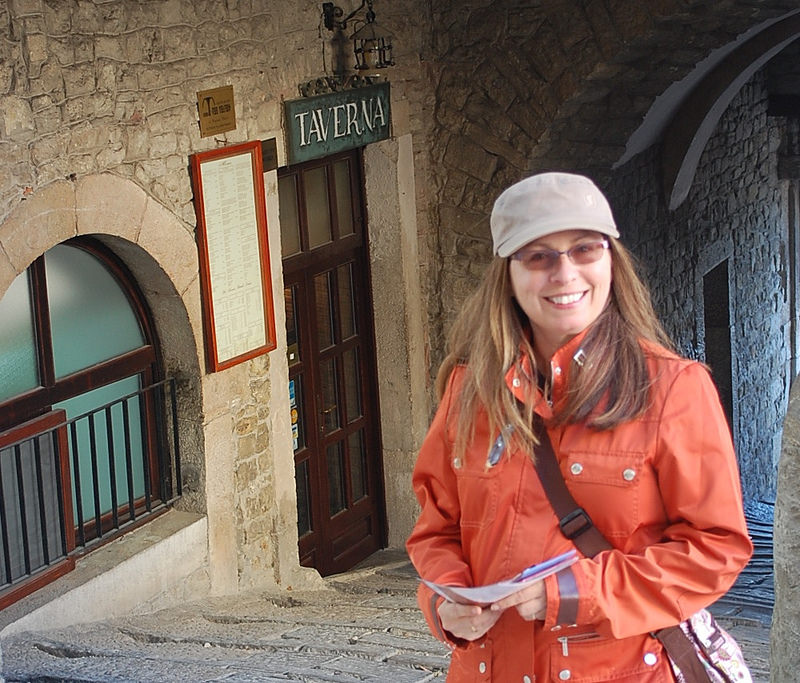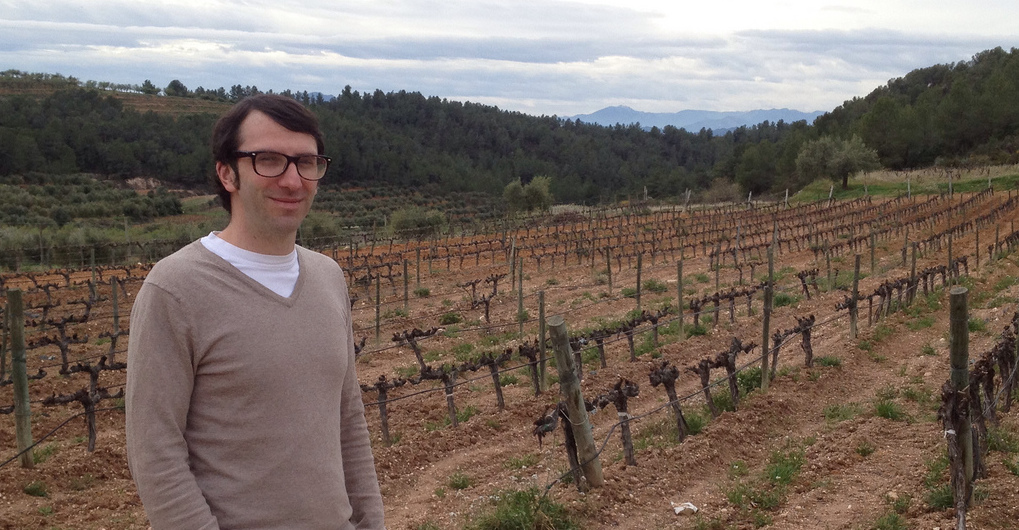
Marcy Gordon encounters unicorns in her glass, entreats you to slow down and enjoy wine country, and sometimes is confused for a leading financial reporter. But don't ask her about debt ceilings, just visit her blog, "Come For the Wine". In our latest series of SpeakEasy interviews with wine bloggers, Gordon talks about how to be a better traveller and storyteller.
I have little to no experience with Croatian wines. Tell me about your recent tasting of them and why we should be on the lookout for these “white unicorns” of the wine world.
In 2011 I was twitterduced (introduced on twitter) to Frank Dietrich, of Blue Danube wine. We hit it off and held a tasting at my house with over 20 different wines from all over Croatia. Afterwards I went to Croatia and my love affair with the wines of Croatia was cemented. I find many of the white wines in Croatia are very captivating—thus the moniker of White Unicorn. Many of the whites have the weight and structure of a red wine and develop and unfold as they warm up.
A few weeks ago we did another Croatian tasting focusing on the wines of Alen Bibich. The most original ‘white unicorns’ are made by Alen Bibich, especially the Lučia made from 100% Debit grapes. I also recommend the Bibich R5, a rich and unctuous blend of Debit, Posip, and Marastina, along with Pinot Grigio and Chardonnay; it’s a marvelous mouthful that is both refreshing and bold.
My new favorite white unicorn is the Bibich Bas de Bas Blanc—a multifaceted “orange” wine made from Debit grapes that spent 3 months on skins in stone vats, then 5 years in oak. It has lot of complexity on the palate with a great weight that belies it’s 12% AVB status. I’m not sure if this is a wine for the masses, but I doubt that’s why Alen made it. The back label reads: “Produced only for true wine lovers.”
It’s getting easier to source Croatian wines in the U.S.-- but the best way to experience the unicorns, is of course, in Croatia.
Switching gears, what makes the wines of Santa Barbara County unique; what were your big takeaways considering the place and its wines from WBC14?
My biggest takeaway was how the minute climate differences of each AVA were so readily apparent in the wines, especially the Syrah. I’ve been buying wines (mainly Rhônes) made by local Northern California winemakers with grapes from vineyards of Santa Barbara such as Bien Nacido, Saarloos, and Zaca Mesa for years, but I’d never really spent any time there.
I was so surprised and impressed with Santa Barbara and the range of the vineyards and great diversity of wines. It just goes to show how important it is to travel to wine regions to see the landscape and experience the wines in their place. I found the wines to be exciting, fresh, and vibrant. They showed a complexity that seemed effortless, but grounded and suffused with an old world sensibility.
In addition to attending numerous Wine Blogger Conferences, you’ve also spoken at Wine Tourism Conferences both domestically and internationally. What trends are you seeing in wine tourism? What are some dos and dont’s from your perspective as a professional and as travelling wine lover?
Active wine travel is a growing trend and continues to be a popular option with tasting and tours centered around biking, kayaking, stand up paddle boarding, even Segway tours. Another trend is educational and hands on experiences, with more wineries offering everything from wine sensory development sessions to cooking lessons and wine blending sessions.
My best “do” advice for wine travelers is pace yourself. Linger and enjoy the area in a leisurely manner. Wine tourism is not only about wine, it’s about the culture, the history, the people, the food, and the landscape of a region. Yes, of course, visit some wineries, but then get out explore the area. Go to a local farmers market, get picnic stuff, grab a bottle and head out to a pleasant spot with a view and enjoy the scenery. Visiting eight or more wineries in one day is not wine tourism—that’s a press trip! Non-stop tasting is grueling and I don’t recommend it. For a great wine tourism experience you need to slow down and drop into the sense of a place. And the best entry point to a place is through the portal of food and wine.
What’s the key to good travel writing? “I was there and this is what I did, blah blah blah.” How do you make the narrative exciting, to move beyond a chronological list of daily activities?
Well it helps to have a focal point to the story, be it historic or contemporary, and build the narrative around it. Most travel writing is “service writing” which is the basic where to go and what to do lists that editors seem to gravitate towards. But I favor the deeper personal travel narratives, ones that take the reader on a journey and connect them to a place in an unexpected way. The best stories are when things go horribly awry. Major dramas or life threatening stuff that is never funny in the moment but becomes a laugh riot in retrospect. I have had more than my share of those moments. But the truism of travel writing is: Great stories happen to people who can tell them.
Tell me about Writing Between the Vines. Is it mostly food and wine writers who end up at this vineyard retreat? What about the experience seems to stand out for most participants?
When I travel, I always love being in or around vineyards when I write and I thought other writers would too. So I created Writing Between the Vines –Vineyard Retreats for Writers, a program that provides writers the time to focus on works in progress or cultivate new ideas in residencies of up to one week in length, surrounded by the beauty of vineyards in locations around the world. The retreat stays are provided free of charge to the writer.
This past season we hosted five writers including Virginie Boone of Wine Enthusiast. The retreats are open to writers of all levels, from emerging to well established, and we encourage applications from food, wine, and travel writers as this particular segment of writers are normally not eligible for traditional writer colonies and residencies.
The standout for most residents is the gift of time to work away from the distractions of their daily life and routine. But many find hiking around the vineyards and exploring the surrounding area to be very inspiring and conducive to the creative process.
This coming season WINTER/SPRING 2015 we will have five vineyard retreat hosts, including locations in Canada and Texas. Applications will open at the end of September for residencies that will be held in Feb and March of 2015. Check out the website for more details.
What does the AP Wine Blogger blog about?
You would think the AP (Associated Press) Wine Blogger blogs about wine, right? Still, I get asked this question frequently. I hate to burst any bubbles here, but the AP Wine Blogger is very much an urban legend. It is the Yeti of wine bloggers, the Sasquatch of the wine press. The flat out truth is I am constantly mistaken for another writer named Marcy Gordon who is not a wine writer, but a financial reporter and analyst for the AP. Anytime she writes something controversial, I get a ton of email. I also get a lot of weird followers on twitter, demanding I write about low interest high ratio dividend debt instruments and banking regulations. I have no idea what they are talking about. But recently several banking people began tweeting to each other using my twitter handle (@marcygordon) and saying how much they like the AP wine blog. Despite my constant efforts to set the record straight, the rumors persist. So now I’m thinking I should just go ahead pitch AP about doing a wine blog, it seems to be what the financial people want.
Anything you want to say about the print writers panel/workshop at the Wine Bloggers Conference (WBC) that hasn’t been said? Or just how you’d like to see a writing workshop structured for WBC15?
Good grief, if I say one more word on that topic, I’ll burst. I outlined a very detailed example of how writing workshops might be organized and run in the future in a post on my own blog and commented about it on several other blogs. But comment strings are the last place to get a point across, or come to consensus on WBC issues. Everyone is in their own private Idaho, with their own agendas and it seems reading comprehension is at an all time low. It would be helpful if the majority of people commenting were informed instead of just opinionated, but that is not the case. My new comment policy on issues pertaining to WBC is “No comment” -- just give me some wine and talk amongst yourselves.
[And on that note, I will never ask another question about that particular panel at WBC14 again.... --JF]










